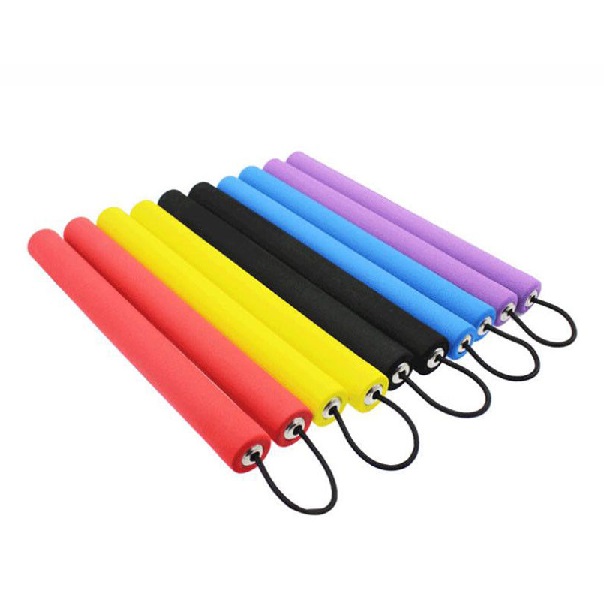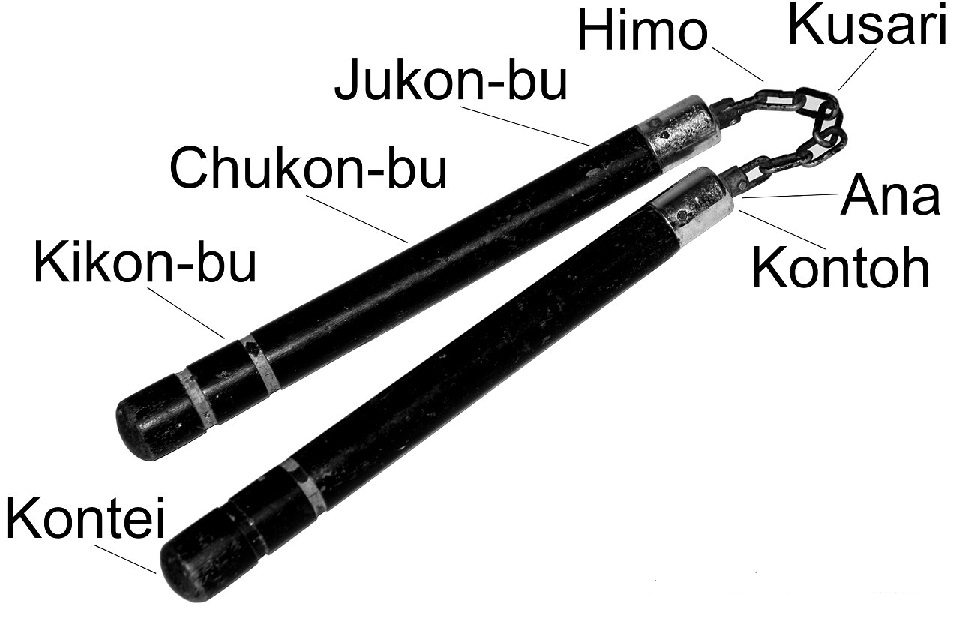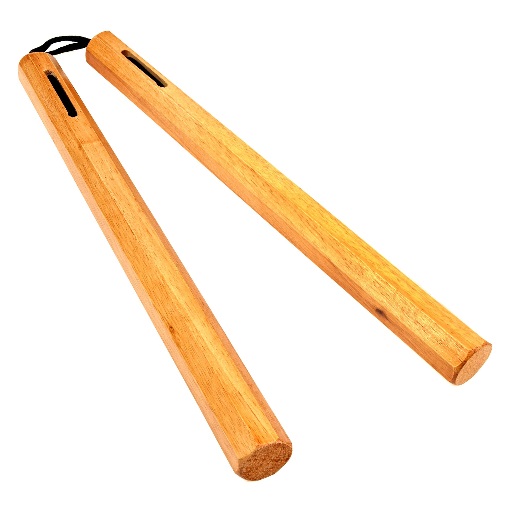The History of the Nunchaku: Unveiling the Mysteries Behind this Iconic Weapon
The Nunchaku, also known as “nunchuks,” is a traditional Okinawan weapon that consists of two sticks connected by a chain or rope. This iconic weapon has been featured in numerous movies and TV shows, making it a recognizable symbol of martial arts.
But where did the Nunchaku originate from, and how did it become so popular? In this article, we’ll delve into the rich history of the Nunchaku, uncovering the mysteries behind this iconic weapon.
Origins of the Nunchaku
The origins of the Nunchaku are shrouded in mystery, but it’s believed that it was first developed in Okinawa, Japan. The Okinawan people were known for their martial arts prowess, and they developed many weapons that were designed to be used in close-quarters combat.
One theory suggests that the Nunchaku was originally used as a tool for threshing rice. The farmers in Okinawa would attach two sticks together with a rope or chain, using them to separate the rice from its husks. Over time, the Nunchaku was adapted for use as a weapon, and its popularity grew.
Certain historians argue that the origins of the Nunchaku are less ambiguous than commonly perceived. They propose that it was initially developed in China and introduced to Okinawa in the 17th century. Like many similar weapons, it was allegedly transported as an agricultural tool, making it immune to confiscation by authorities.
This so-called farming implement gradually integrated into the martial arts practices of the lower classes. However, the extent to which it was actually used for farming remains uncertain.
Despite the varying beliefs about the Nunchaku’s origins, there’s no denying its significant impact. Regardless of its true roots or frequency of use, this weapon remains one of the most glorified representations of Okinawan weaponry in contemporary media and popular culture.
The Nunchaku: A Comprehensive Guide to its Fascinating History
The Nunchaku has become a worldwide icon of martial arts. This weapon has been featured in countless movies and TV shows, making it a recognizable symbol of strength, power, and agility. In this section, we will explore the fascinating history of the Nunchaku, including its origins, evolution and cultural significance.
The origins of the Nunchaku are believed to be in Okinawa, Japan, where it was developed by farmers as a tool for threshing rice. The Nunchaku is made up of two sticks that are connected by a chain or rope. The farmers would use the Nunchaku to separate the rice from its husks by striking it against the threshing floor.
Over time, the Nunchaku was adapted for use as a weapon, and its popularity grew. It is believed that the Okinawan people began to use the Nunchaku for self-defense and as a tool to subdue armed opponents.
Evolution of the Nunchaku
As the Nunchaku evolved into a weapon, it was refined and developed by martial artists. One of the most influential martial artists in the development of the Nunchaku was Matsumura Sokon. Matsumura Sokon was a martial artist and military officer who lived in Okinawa in the mid-19th century. He was known for his expertise in a variety of martial arts, including Karate and Kobudo.
Matsumura Sokon was instrumental in developing the Nunchaku as a weapon for self-defense. He modified the original design by adding weights to the ends of the sticks, which increased the weapon’s striking power. He also developed new techniques for using the Nunchakus, including striking, blocking, and trapping.
Popularity of the Nunchaku
The Nunchaku gained widespread popularity in the 20th century thanks to martial arts movies and TV shows. Bruce Lee, in particular, helped to popularize the Nunchaku in the United States with his iconic performance in “Enter the Dragon.”
However, the Nunchaku’s popularity hasn’t been without controversy. In some parts of the world, including the United Kingdom and Australia, the Nunchaku is classified as an illegal weapon. This has led to debates about whether the Nunchaku should be banned or not.
Cultural Significance of the Nunchaku
The Nunchaku has become a cultural symbol of martial arts, and it is revered by practitioners all over the world. It has been used in countless movies and TV shows, including the popular “Teenage Mutant Ninja Turtles” franchise and the “Kill Bill” movies.
However, the Nunchaku’s cultural significance goes beyond its use in popular culture. It is seen as a symbol of strength, power, and agility, and it is often used in demonstrations and competitions. Many martial arts schools offer Nunchaku training as a way for students to improve their skills and develop their martial arts knowledge.
Controversies Surrounding the Nunchaku
Despite its cultural significance, the Nunchaku has been the subject of controversy in some parts of the world. In some countries, including the United Kingdom and Australia, the Nunchaku is classified as an illegal weapon. This has led to debates about whether the Nunchaku should be banned or not.
In the United States, the legality of the Nunchaku has also been challenged. In 1974, Bruce Lee’s movie “Enter the Dragon” helped to popularize the Nunchaku in the United States. However, the movie also led to concerns about the weapon’s safety, and some states banned the Nunchaku altogether.
Techniques and Training
The Nunchaku is a versatile weapon that can be used for both offense and defense. However, using it effectively requires training and practice. There are many techniques that can be used with the Nunchaku, including strikes, blocks, and throws.
Training with the Nunchaku can be challenging, but it’s also incredibly rewarding. It requires focus, coordination, and discipline, making it an excellent way to improve your overall martial arts skills.
Figure 8
One of the most basic Nunchaku techniques is the figure-eight motion. This technique involves swinging the Nunchaku in a continuous figure-eight pattern, with the chain or rope passing behind the body between each loop. The figure-eight motion can be used to create momentum and striking power, as well as to intimidate opponents with the weapon’s speed and unpredictability.
Butterfly Spin
Another common Nunchaku technique is the butterfly spin. This technique involves holding the Nunchaku in one hand and spinning it in a circular motion, with the chain or rope passing around the fingers and hand. The butterfly spin can be used to create distance between the user and an opponent, as well as to distract or confuse the opponent with the weapon’s fast and flashy movements.
Nunchaku Overhead Strike
The overhead strike is a powerful Nunchaku technique that involves swinging the weapon over the head and striking downward with one or both handles. This technique can be used to deliver a powerful blow to an opponent’s head or upper body, and is often used in self-defense situations.
Nunchaku Horizontal Strike
The horizontal strike is another effective Nunchaku technique that involves swinging the weapon horizontally and striking an opponent’s body with one or both handles. This technique can be used to target an opponent’s legs or torso, and can be executed with speed and precision for maximum impact.
Other Nunchaku techniques include the reverse grip, where the weapon is held with the handles pointed downward, and the wrist flick, which involves flicking the Nunchaku with the wrist to create fast and unpredictable movements.
It is important to note that Nunchaku techniques require a great deal of practice and skill to master. Proper technique and form are essential for both safety and effectiveness when using the weapon. It is recommended that beginners seek the guidance of a qualified martial arts instructor to learn the proper techniques and safety protocols for Nunchaku.
Nunchaku techniques are a crucial part of using this traditional weapon for martial arts and self-defense. From the basic figure-eight motion to the powerful overhead strike, the unique design of the Nunchaku allows for a wide range of techniques and movements. With proper training and practice, Nunchaku can be an effective and versatile weapon for any martial artist or self-defense practitioner.
Formal vs Freestyle
Nunchaku can be wielded in two distinct manners: formal and freestyle. The latter, often depicted in films and TV shows, is more commonly recognized.
The differences between the two are:
-
In a formal style, the Nunchaku is employed in various martial arts, including Jujitsu, Karate, Filipino martial arts, and Korean martial arts. These diverse systems incorporate a range of moves beneficial for both offensive and defensive strategies. Learners are instructed not only in spinning the Nunchaku but also in using it as a weapon for striking and self-defense. Formal training emphasizes self-control and posture. Without mastering these elements, there’s a risk of inadvertently hitting oneself, causing pain and potential embarrassment.
-
Freestyle usage, on the other hand, focuses more on performance techniques that might not be covered in formal styles like Karate. Instead of being utilized as a weapon, the Nunchaku serves as a visual tool to captivate audiences and educate them about this unique item. The popularity of freestyle has surged with the availability of instructional videos on platforms like YouTube. However, it’s crucial to note that beginners should seek professional guidance before attempting to learn independently to avoid serious injury.
Regardless of the chosen style, many martial arts instructors encourage their students to learn Nunchaku handling. These weapons have proven to enhance hand-eye coordination, overall balance, and posture. They also help to refine reflexes, among other benefits, which can vary from one student to another.
Training Nanchaku

Foam Nunchaku designed for training purposes are a safe and effective way to learn this ancient martial arts weapon. These Nunchaku are covered in foam, providing a cushion that minimizes the risk of injury during practice. They are ideal for beginners who are just starting their journey with this unique weapon, allowing them to build confidence and develop their skills without fear of hurting themselves.
The foam Nunchaku are available with either a ball bearing chain or cord connection. The ball bearing chain option generally comes in three colour choices: black, red, yellow or blue. This type of connection allows for smooth and fluid motion, replicating the movement of traditional Nunchaku. The cord option is available in black, provides a slightly different handling experience, offering a bit more control and stability.
Each stick of the training Nunchaku generally measures 28cm in length and has a diameter of 3cm, excluding the head of the chain. This size is designed to be comfortable for a wide range of users, providing a good balance between control and power.
The chain on training Nunchaku generally features seven links and measures approximately 14cm. This length offers ample space for the Nunchaku to swing and spin freely, facilitating a variety of maneuvers and techniques.
Training foam Nunchaku are an excellent tool for anyone looking to explore the art of Nunchaku. Their safe and user-friendly design makes them a popular choice for learners at all levels.
Nanchaku Anatomy
Below are the sections of the Nunchaku.
- Ana: the hole on the kontoh of each handle for the himo to pass through—only nunchaku that are connected by himo have an ana.
- Himo: the rope which connects the two handles of some nunchaku.
- Kusari: the chain which connects the two handles of some nunchaku.
- Kontoh: the top of each handle.
- Jukon-bu: the upper area of the handle.
- Chukon-bu: the center part of the handle.
- Kikon-bu: the lower part of the handle.
- Kontei: the bottom of the handle

Credit Wikipedia
Nanchaku Construction
Nunchaku construction of Nunchakus has been refined over the years, and modern versions of the weapon are made with high-quality materials to ensure durability and functionality.
The two sticks, also known as handles or grips, are typically made of hardwood, such as oak or ash. These woods are preferred for their strength and durability, as well as their aesthetic qualities. The handles are often carved or sanded to provide a comfortable grip, and some modern training Nunchaku have rubber or foam padding to reduce impact and provide a more secure hold.
The chain or rope that connects the two handles is an essential part of the Nunchaku construction. In traditional Nunchaku, the chain was made of horsehair or other natural fibers. However, modern Nunchaku typically use metal chains with ball-bearing joints or synthetic ropes made of materials such as nylon or PVC. The choice of material for the chain or rope depends on the intended use of the Nunchaku, as well as personal preference.
One of the most important aspects of Nunchaku construction is the connection between the handles and the chain or rope. This connection must be secure enough to withstand the force of swinging the Nunchaku without breaking or coming loose. In traditional Nunchaku, the handles and chain were connected by a knot or simple binding. However, modern Nunchaku often use more advanced connections, such as screws or rivets, to ensure a more secure and reliable connection.
Finally, some Nunchaku may have additional features or accessories that enhance their performance or appearance. For example, some modern Nunchaku may have weighted ends or chains to provide more momentum and striking power. Others may have decorative tassels or beads for added style.
The construction of Nunchaku has evolved over time to incorporate new materials and designs. Modern Nunchaku are typically made with high-quality hardwood handles, metal chains, and advanced connections for a more secure and reliable weapon. The choice of materials and design features depends on the intended use of the Nunchaku, as well as personal preference. With proper construction and care, Nunchaku can be a durable and effective weapon for martial arts and self-defense.
Final Thoughts
The Nunchaku is a fascinating weapon with a rich history and a global following. Its origins may be shrouded in mystery, but its popularity is undeniable. Whether you’re a martial arts enthusiast or simply a fan of action movies, the Nunchaku is sure to capture your attention. In conclusion, the Nunchaku is more than just a weapon, it’s a symbol of martial arts culture and history. Its popularity has endured for centuries, and it’s likely to continue to be an iconic part of the martial arts world for many years to come.
Excited to Discover More?
We trust you found this article engaging. If you’re passionate about learning more about traditional martial arts weaponry, we suggest you read the articles below.
Next Martial Arts Weapons article: How to Use the Bo & Eku (Kobudo Long Weapons)
Previous Martial Arts Weapons article: The Tonfa Traditional Martial Arts Weapon
Have a look at this extensive article that offers a deep dive into the world of Martial Arts Weapons here at Dojo Directory.


